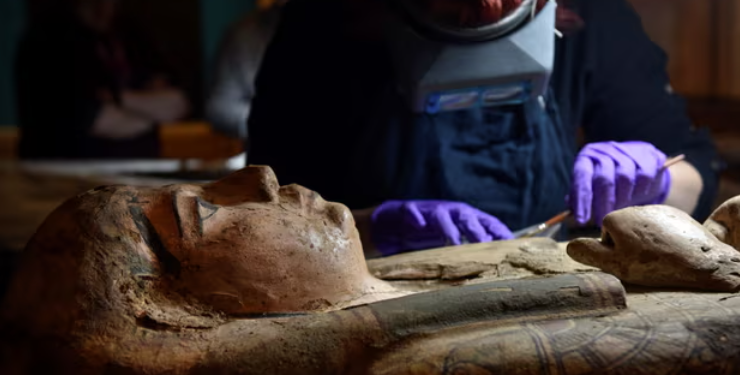Nov 8, 2024 Story by: Editor
A cherished artifact at the Perth Museum, an ancient Egyptian sarcophagus, has captivated visitors since it was donated to the Scottish collection in 1936. Now, the museum offers a fresh perspective on the woman inside, believed to have been mummified around 2,500 years ago, by digitally reconstructing her face. Experts believe this woman, buried in the sarcophagus, was a Black individual from the Kingdom of Kush, an ancient empire that once controlled Upper Egypt and encompassed present-day Sudan. Both the reconstructed head and her sarcophagus will be featured in the upcoming “Waters Rising” exhibition, opening today, November 8.
Dr. Chris Rynn, a craniofacial anthropologist and forensic artist, led the facial reconstruction. He noted unique characteristics in the skull that distinguished it from typical ancient Egyptian remains. “The skull shape doesn’t look like any of the ancient Egyptians that I’ve seen before. Kemetic skulls normally have narrow long craniums, more prominent narrow noses, and longer faces,” Rynn explained to the Observer. He added that his reconstruction method is based on scientific principles, with no room for artistic interpretation until the final photo-realistic textures and colors.
Rynn believes the woman was likely Black, a theory supported by regional historical and archaeological context. Hieroglyphics on her sarcophagus identify her as “Ta-Kr-Hb” or “Takerheb,” suggesting she may have been a priestess or princess who died in her thirties and suffered from severe tooth decay. She is believed to have lived during Egypt’s 25th-26th dynasties (c. 760-525 BC).
Dr. Mark Hall, the museum’s collections officer, confirmed, “What we now know from Chris’s facial reconstruction is that the female is Kushite. She’s from the kingdom of Kush, which was a neighbor of Ancient Egypt in Sudan. At this particular time, 2,500 years ago, that’s when the Kushite empire conquered Egypt, and you get a whole sequence of Black, Kushite pharaohs.”
Rynn, who usually works with international police to help identify bodies from skeletal remains, noticed a marked difference between Ta-Kr-Hb’s facial features and those depicted on her sarcophagus. “The face on the sarcophagus is totally different – a long face with a long narrow nose. I looked into how unusual it is that the sarcophagus did not look like its inhabitant. It was quite common,” he said, noting that the inside lid painting portrayed a woman with much darker skin.
In Rynn’s reconstruction, Ta-Kr-Hb is shown with a shaved head, as was customary for priests and priestesses involved in embalming due to both ceremonial and hygiene purposes. If she was a princess, she might have worn a ceremonial wig, Rynn speculated.
João Philippe Reid, the museum’s exhibitions manager, emphasized the museum’s commitment to uncovering hidden histories. “We’re very interested in exploring hidden histories and marginalized stories, looking at places where museum collections are not representative of the perspectives and experiences of societies today, and in the past. Seeing a Sudanese face appear is really exciting. These histories are hiding in plain sight,” he remarked.
The sarcophagus itself has an intriguing journey, believed to have been discovered in the late 19th century and later sold by a Cairo museum to an Alloa businessman. It eventually found its way to Perth around 1892. Additionally, the museum’s collection houses the Stone of Destiny, also known as the Stone of Scone, used in crowning British monarchs.
The “Waters Rising” exhibition will address climate change through historical artifacts, including this sarcophagus, which was once damaged by Nile flooding. Hall expressed enthusiasm about unveiling Ta-Kr-Hb’s likeness: “We hope it gives visitors the feeling that here’s someone you can readily relate to as another human being.” Source: The Guardian

















